Sustainability for Multifamily: The Complete Guide

Sustainable capital planning is no longer just an ethical choice. Due to changing regulations, investor preferences, tenant demands, and climate-related risks, sustainability is key to financial viability.
The problem is that few sustainable projects actually pencil. And even when they do, execution often stalls. What’s more, data problems extend timelines and silo interdependent teams, which torpedoes ROI and prevents effective portfolio-level capital planning.
But these problems are solvable. And the impetus to solve them has never been stronger.
This piece breaks down:
- The financial, regulatory, and capital market factors driving climate action.
- Seven sustainability projects that are consistently financially viable.
- The challenges that prevent project, property, and portfolio-level execution, and how to overcome them.
The 3 Main Drivers of Sustainability Projects

While a desire to do right by our planet drives owners to pursue sustainability initiatives, reality comes on quickly. Tight margins in the middle of a challenging market squeeze good intentions.
Thankfully, there are compelling, hard-nosed dollars-and-cents reasons to implement climate and sustainability initiatives. These financial benefits—which are becoming increasingly prevalent—make sustainability projects good, rational bets for any business, in this or any economic climate.
To that end, this section will delve into the three main drivers of sustainability projects. These include:
- Financial Risks and Rewards: The downside of inaction and the upside of proactive investment.
- Investor Influence: How access to capital is increasingly tied to sustainability performance and climate risk management.
- Evolving Regulations: The threats of non-compliance and the opportunities presented by changing regulations.
Driver 1: Financial Risk and Rewards

The financial risk of deferred sustainability retrofits for existing builds is downward pressure on asset values. In the most dire case, a stranded asset, this risk is unlimited. A stranded asset is a building that doesn’t meet certain standards and is illegal to rent or sell, leading to premature obsolescence and significant write-downs.
For instance, New York’s Local Law 97 (LL97) mandated that most buildings over 25,000 square feet meet strict GHG emissions limits starting in 2024. More aggressive targets must be hit by 2030 and the goal is to reach net zero by 2050. If a building owner doesn’t invest in capital projects necessary to meet the LL97 threshold, the property becomes harder to finance or sell at market values and potentially unprofitable due to fines.
Similar international, national, state, and local regulations are becoming increasingly common.³
Yet there’s also a potential upside—both in terms of increased revenue and reduced OPEX—for proactive, strategic sustainability-driven capital planning.

Driver 2: Investors

Success in real estate requires access to capital at favorable terms. And investors increasingly factor sustainability in their funding evaluations.
According to the UN Environment Programme Finance Initiative’s Sectoral Risk Briefing, “A growing number of investors are aligning their portfolios with the Paris Agreement through net-zero commitments by joining initiatives such as the Net-Zero Asset Owner Alliance and Climate Action 100+.”
In short, capital markets have begun to favor sustainable players. McKinsey predicts that this shift will be “one driver of a rapid increase in demand for ESG-friendly buildings.”
This isn’t just about optics. The risk of future events have significant, negative impacts on real estate values that investors can’t ignore, which the following data points demonstrate:
- Reduced demand: The effects of a hurricane on property value and investor returns “can last up to five years, peaking three years after a major hurricane due to higher risk.”
- Increased insurance expense: Risk-based insurance pricing would yield a 29.4% increase in average insurance premiums across the United States by 2055.9
- Increased risk of financial burden: Regulators in over 50 countries have either established or are planning some form of carbon taxation.
An asset’s risk profile is fundamental to its value. And climate change brings a whole host of changes to risk analysis via climate-related physical risks, sustainability-related compliance risks, and other risks, such as loss of insurance coverage, or reputational damage.
Sustainable upgrades not only mitigate these risks, but they also increase the potential return of an asset through (but not limited to) the following:
- Higher sales prices: Energy efficiency improvements can increase the price of residential assets by 3 to 8% and by 10 to 20% for commercial buildings.
- Rental premiums: Studies show a correlation between energy-efficient buildings and higher rents, indicating rental premiums
- Improved insurability: Proactive climate-ready construction and retrofits can improve the insurability of properties.
Driver 3: Regulations
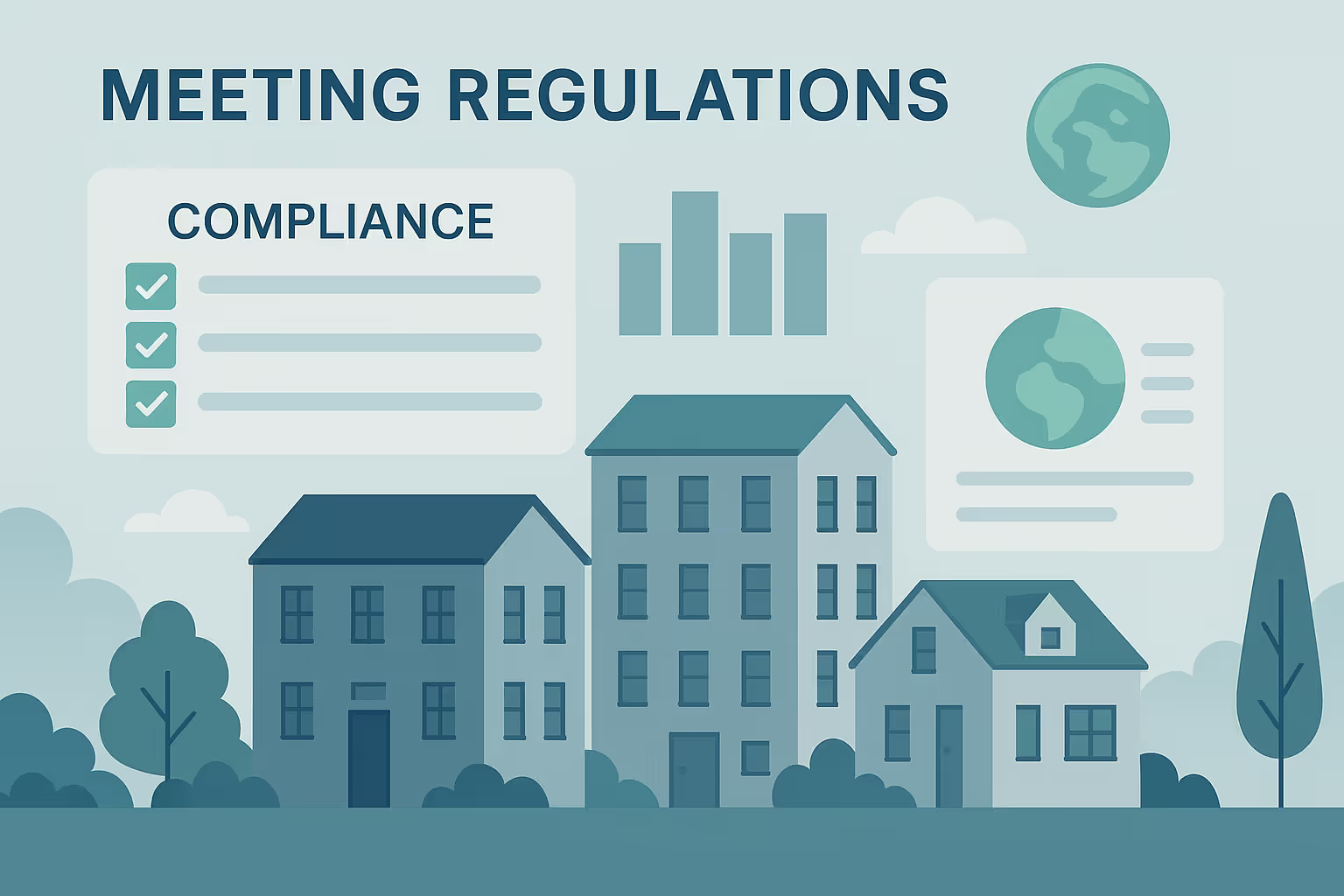
Regardless of short-term swings in political winds for or against sustainability, the long-term trend is and has been toward more stringent regulation.
This presents both threats and opportunities, examples of which are shown in the tables below.
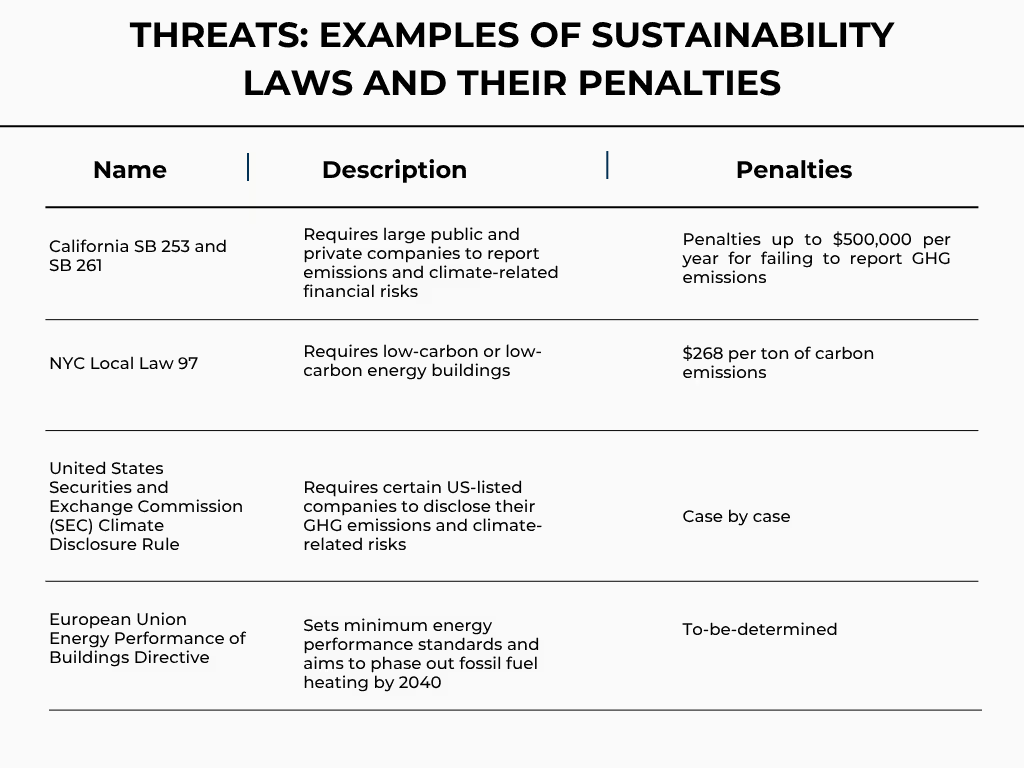
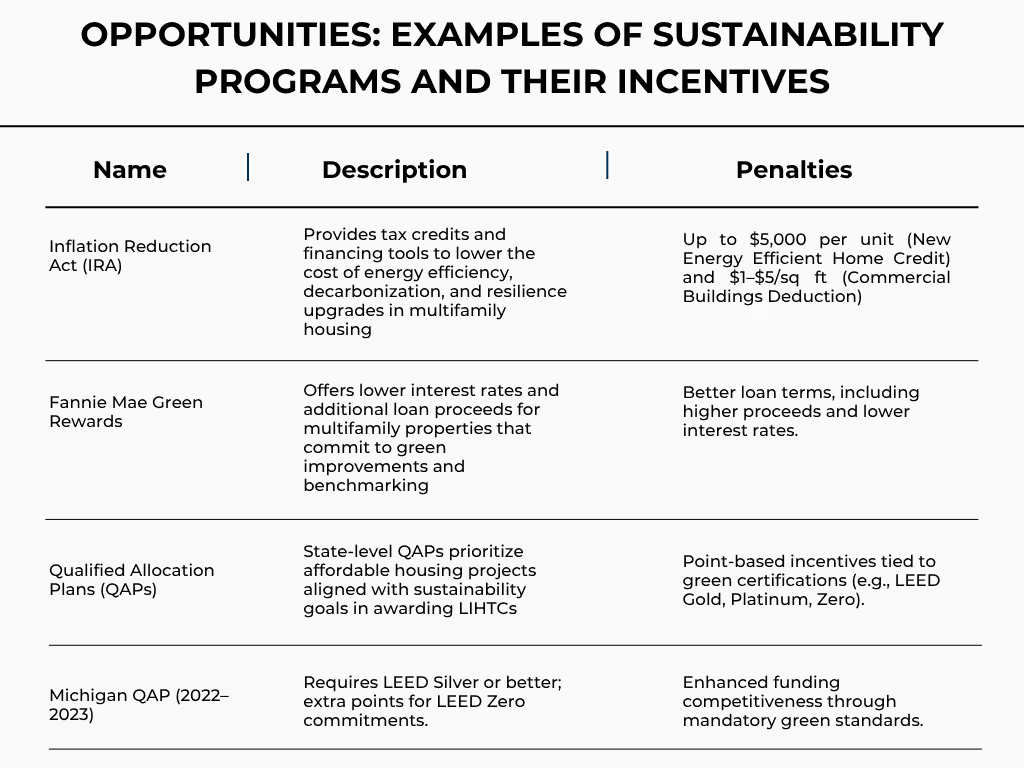
Understanding sustainability regulations positions owners to navigate these threats and capitalize on opportunities. Rather than keeping up with compliance, the best owners will stay ahead to mitigate risk and access subsidies. And they will leverage those advantages to improve asset value and attract investors.
Given this strategic overview, in the next section, we will delve into a shortlist of sustainability projects proven to be financially viable for multifamily properties. That way, we can see specific types of sustainability projects and how they tap into one or more of the three drivers.
The 7 Sustainability Projects That Actually Pencil for Multifamily

We selected the projects we are about to explore because the numbers work for them. In the proper strategic context, all of these projects can leverage each of the drivers outlined above:
- Driving Financial Rewards: Increase revenue and reduce OPEX.
- Mitigating Financial Risks: Avoid fines for non-compliance and reduced asset values.
- Attracting Investors: Align with the preference of private and institutional investors.
- Leveraging Regulatory Opportunities: Access valuable subsidies and favorable financing.
1. Solar: Rooftop, parking canopies, greenfield
Solar photovoltaic (PV) systems generate electricity, cut energy bills and reduce emissions. As utility rates rise, the ability to lock in lower long-term energy costs adds to solar’s appeal as a profitable capital project, both in terms of lower OPEX and as an attractive property amenity.
In addition to its contribution to lower OPEX and tenant appeal, solar projects are also often eligible for government subsidies and tax credits. The Inflation Reduction Act (IRA) extended the Investment Tax Credit (ITC), which can cover up to 30% of solar project costs. If the project meets prevailing wage requirements or benefits low-income communities, bonus credits up to 20 percentage points are available. Solar is also eligible under Fannie Mae’s Green Rewards program.
2. LED Lighting: Simple, measurable, high-yield
LED lighting upgrades offer one of the highest returns on investment in multifamily. They reduce electricity use by up to 75% compared to traditional lighting and are fast to implement. Because energy savings begin immediately and maintenance costs drop, payback periods are typically short. Like solar, these upgrades also appeal to tenants and bolster sustainable branding efforts.
LEDs qualify under Fannie Mae’s Green Rewards and the IRA’s Section 179D deduction if they reduce energy costs by at least 25%. Put simply, for owners aiming to cut operating expenses without large capital investments, LEDs are a proven, low-risk path to measurable impact.
3. Windows & Doors
Inefficient windows and doors are a primary cause of heating and cooling loss in multifamily buildings. Upgrading windows can significantly reduce these losses, especially if the upgrade is a high-performance alternative, such as an ENERGY STAR-rated option. Along with window upgrades, properly sealed doors reduce energy loss, improve energy efficiency, and enhance insulation.
Combined with other green technologies, windows and doors improve a building's overall energy performance by supporting the efficiency of the entire system. Window upgrades may also be eligible for rebates through the Home Efficiency Rebates program, worth up to $8,000 per unit or 80% of project costs for low-income buildings.
4. Insulation: Interior and exterior retrofits, including roof insulation
Exterior and interior insulation are foundational to efficient buildings. According to McKinsey, upgrading building envelope components like insulation can reduce energy demand by about 30% over 50 years. In the European Union, where 70 percent of energy consumption relates to heating, insulation is highlighted as one of the most cost-effective approaches to emissions abatement.
Well-insulated buildings are also more resilient to power outages and offer enhanced grid flexibility. For example, switching off a heat source in a well-insulated building can have little impact on indoor temperatures. This helps manage peak electricity demand and contributes to grid stability. Like window upgrades, insulation retrofits are a force multiplier because renewable technologies perform significantly better in well-insulated buildings.
5. Electrification: Remove gas appliances; install electric + heat pumps
Electrification swaps fossil fuel-burning equipment for electric systems like induction stoves and heat pumps. Benefits include avoiding future fuel-switch penalties, improved indoor air quality, and the potential to optimize power procurement. Of course, renewable energy sourcing and rules regulating power purchase agreements vary by market, but many multifamily owners can coordinate electrification with clean energy purchasing to reduce costs.
And while electrification can be costly in older buildings due to necessary infrastructure upgrades, government programs may provide some relief now and in the future. The IRA's Home Electrification and Appliance Rebates has dedicated funding for low-income multifamily to reduce the costs of electrification.
As gas bans and carbon caps expand, electrification is both a hedge and a pathway to decarbonization, especially when paired with strategic capital planning.
6. Heat Pumps: Replace HVAC and centralized boilers
Heat pumps offer efficient heating and cooling using electricity, making them a key enabler of building decarbonization. According to IEA, by 2030, in a scenario where national climate and energy security targets are met, heat pumps are projected to contribute nearly half of the global reductions in fossil fuel use for heating in buildings.
Heat pumps are three to five times more energy efficient than natural gas boilers.16 When installed in well-insulated units, they’re cost-neutral or better compared to traditional HVAC. And bundling heat pump installations with renovations, such as insulation upgrades, lowers costs and ensures long-term system efficiency.
7. Plant-Level Equipment
Replacing or optimizing aging plant-level systems such as boilers, chillers, and pumps, can yield significant efficiency gains. Early equipment replacement also prevents expensive mid-life retrofits and aligns with long-term decarbonization goals. While these are typically more capital-intensive upgrades, coordinating them with other capital projects like roofing or insulation can reduce labor and design costs.
If these projects achieve required energy cost savings, they can also qualify for Fannie Mae’s Green Rewards and the IRA’s Section 179D deduction, further improving their ROI.
Of course, even when you know what to do and why to do it, integrating sustainability into your capital planning is still challenging.
So in the next section, we’ll go through why these projects are so difficult. Then, we’ll explain how to overcome the unique challenges these sustainable projects present.
The 3 Challenges of Sustainability Projects and How to Solve Them
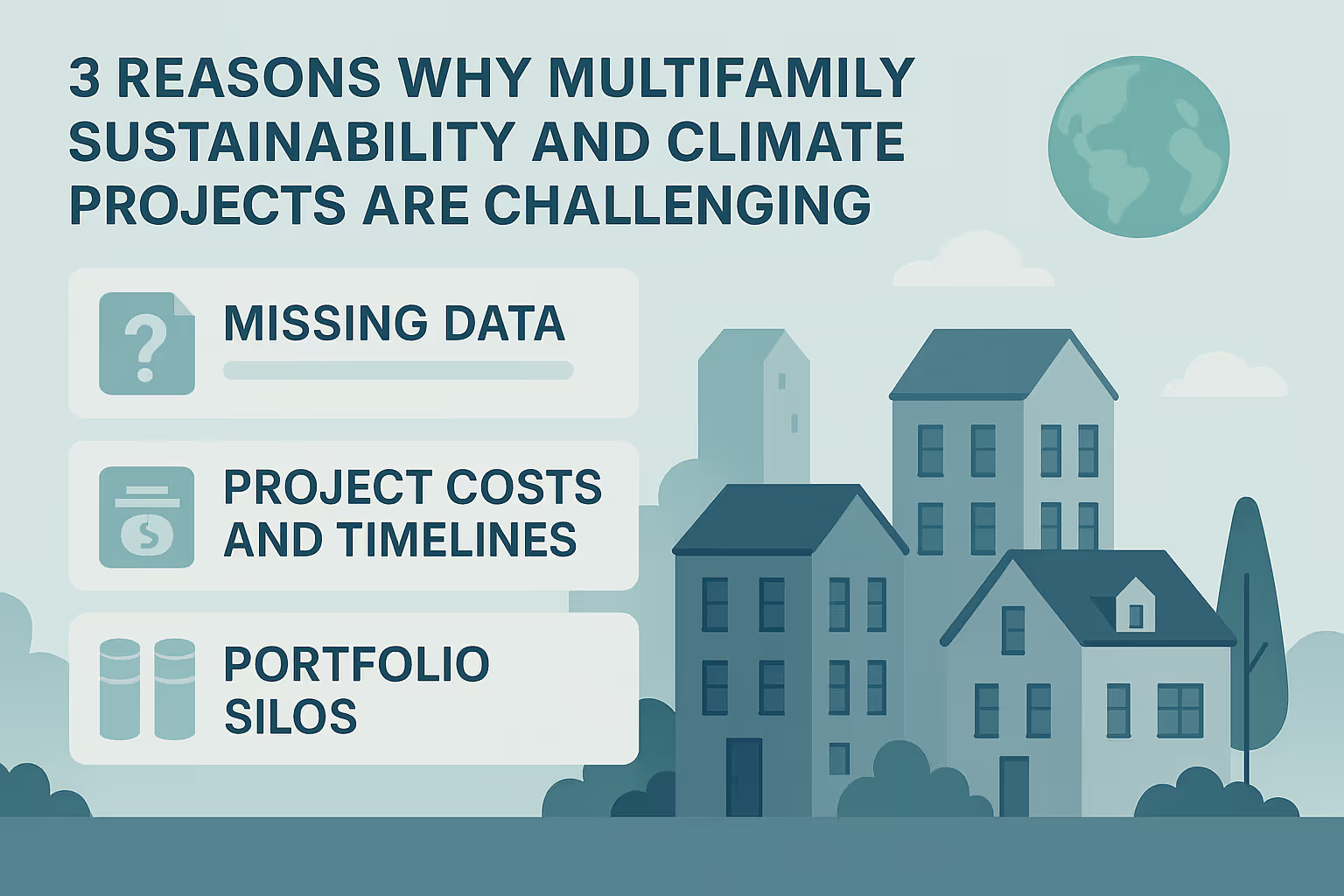
The difficulty in planning and executing sustainability initiatives boils down to issues with project scope, speed, and scale.
The project scope is often poorly defined, or not at all. This results in delays, which slows planning and execution, and causes ROI to suffer. Together, these problems prevent planning at scale, which further limits ROI and reduces the environmental impact of these projects.
In this section, we’ll outline these issues in detail, so we can then show you how to work around them.
Challenge 1: Incomplete Property Data Undermines Sustainable Capital Planning
Most older buildings don’t have accurate, up-to-date property data. Floor plans, HVAC system specs, and inspection records are old, missing, and buried in file cabinets. This makes it difficult to identify climate upgrade opportunities and plan them with confidence. Time is wasted on site visits and compiling fragmented data—rent rolls, maintenance logs, inspection notes—into spreadsheets that are difficult to trust.
The result is inconsistent scoping, slow decisions, and frequent rework. Different teams evaluate the same property and reach different conclusions. Replacements happen too early or too late, which wastes capital, degrades the tenant experience, or both. These data gaps delay execution, inflate costs, and eat away at the profitability of sustainability projects.
Challenge 2: Climate Projects Can Be Too Slow and Costly
Many financially viable sustainability projects stall out because of failures in execution. Planning, scoping, and bidding take too long, which makes good, positive NPV projects look bad. This is because, without complete property data and clear project scopes, vendors can’t deliver accurate bids. And without accurate bids, the back and forth with vendors to revise numbers, redline contracts, and renegotiate compounds.
This slows progress and increases risk. Budgets become unreliable, directly leading to cost overruns and indirectly to project delays. These inefficiencies compound. One project’s delayed, another’s dropped, and the potential to cost-effectively reduce a property’s emissions and its OPEX is lost. The challenge isn’t that the projects don’t pencil. It’s that the process is inefficient and error-prone.
Challenge 3: Scaling Climate Execution Requires Portfolio-Wide Alignment
To most owners, sustainable upgrades sound great. The problem is turning sustainable upgrades into an integrated component of portfolio-level financial planning to maximize impact and cost efficiency. That requires integrating sustainable capital planning within acquisition and asset management processes. But without standardized project data, portfolio-level coordination is difficult at best.
Even if it were possible without standardized data, maximizing the benefit of sustainable capital planning requires transparent reporting. Reporting provides the necessary proof to open up new avenues to capital markets, facilitate compliance, and bolster brand building. Without better tools and data, every project is a one-off. The ROI and climate impact of the project are vague or misunderstood, and the gap widens between climate ambition and execution.
Overcoming these problems requires a strategic, efficient approach to which projects get done, as well as when, and how they get done. Tailorbird makes that smart, strategic approach possible.
How Tailorbird Makes These Projects Viable
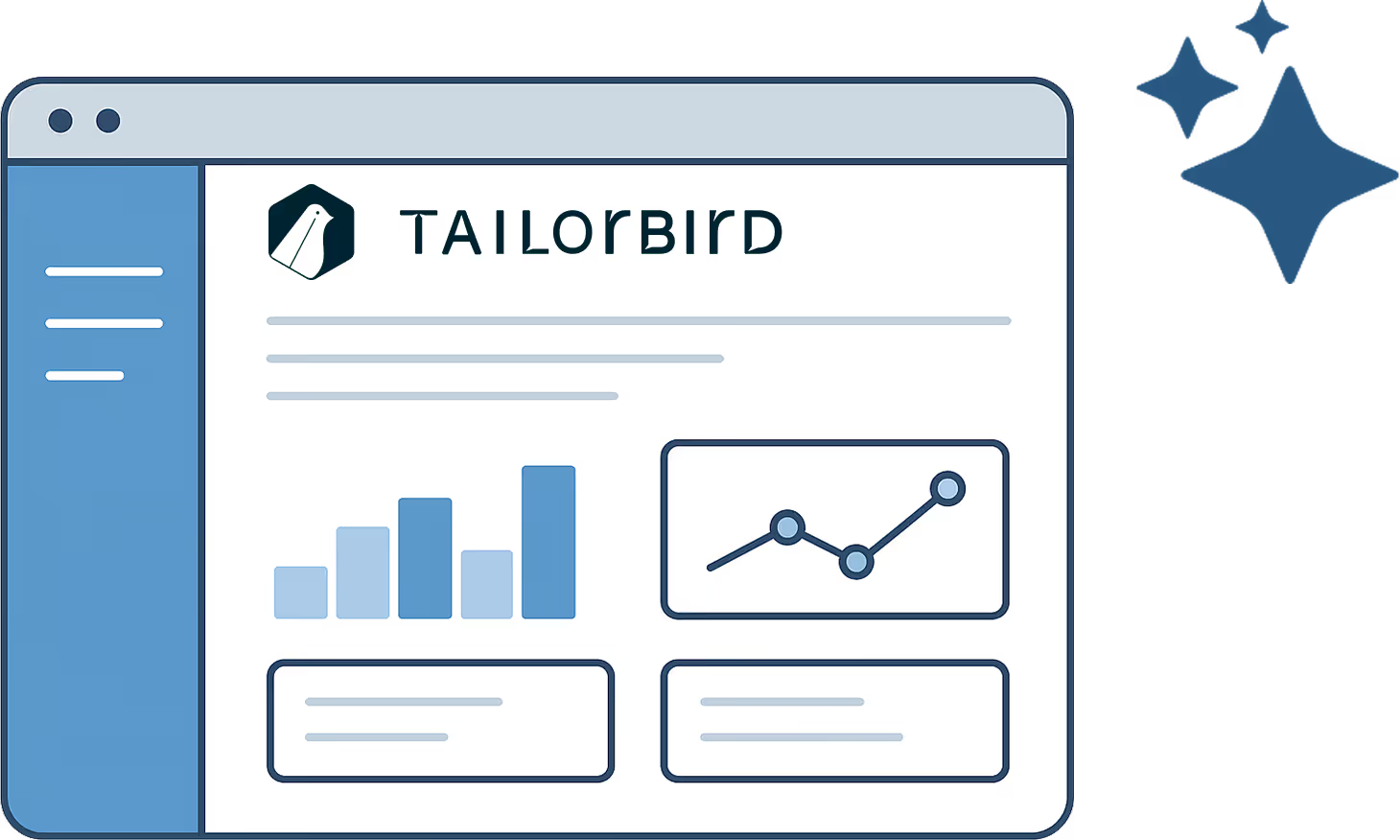
Tailorbird is an AI-driven platform that automates, simplifies, and streamlines every stage of collecting property data, planning capital projects, and tracking them from launch to close-out.
Tailorbird brings AI to all seven of the sustainable renovations outlined earlier in this piece. And it’s the fastest, easiest way to:
- Connect sustainable capital project plans to real, accurate property measurements.
- Create high-quality scopes, solicit hard bids, and set real budgets.
- Scale sustainable projects portfolio-wide.
Here’s how Tailorbird solves each one of the problems outlined above.
Solution 1: Fast, Accurate Property Data and Scoping—at Scale

Tailorbird replaces slow, manual data collection with AI-powered modeling. With just a property address, it captures over 300,000 data points in three days, with 98%+ accuracy. Data points include everything you need to accurately scope sustainable projects—EUL/RUL for systems, roof plans, glazing ratios, unit details, and more.
Tailorbird analyzes documents, images, and serial plates to create a single, shared source of truth. Because data collection happens remotely and in parallel across dozens of buildings, no site visit is required. Scoping is directly tied to accurate price-by-quantity takeoffs, which facilitates faster, more reliable budgets and hard vendor bids. The result is a complete property-level understanding that provides the confidence needed to plan smart, sustainable upgrades.
Solution 2: Faster Project Planning That Makes Sustainability Pencil

Tailorbird streamlines the entire capital project planning workflow from scoping and budgeting to bidding and documentation. It turns standardized property records into prioritized project plans and automatically calculates takeoffs, accelerating vendor bidding in the process. Based on the data it collects and you provide, Tailorbird generates contracts automatically.
What typically takes over five months is done in less than one. On projects planned with Tailorbird, project costs fall up to 8%. Capital projects launch faster, with fewer surprises and tighter control. All this turns borderline projects into sustainability initiatives that pencil.
Solution 3: Portfolio-Scale Planning and Execution

Tailorbird enables owners to plan and execute climate projects at the portfolio level through parallel data collection, centralized planning, and cross-property visibility. Using Tailorbird assets managers and acquisitions teams, can model payback, replace assumptions with verified system data, and align sustainability initiatives with investment logic.
Tailorbird is the first platform to unite acquisition, construction, and asset management, enabling the evolution of sustainability from isolated efforts to integrated strategy. Standardized data also supports ESG reporting and regulatory compliance, which reduces the cost of compliance and improves access to green capital.
One platform. Dozens of projects. Real momentum toward net zero.
Sustainability in Multifamily is No Longer Optional
Approximately 26 percent of all greenhouse gas emissions and 37 percent of combustion-related emissions come from the construction and operation of the built environment.
To keep global warming within approximately 1.5°C and to reach a net-zero-carbon building stock by 2050, the IEA estimates direct building emissions need to be reduced by 50 percent by 2030. This means that changing how we build new buildings isn’t nearly enough, because the vast majority of the building stock that will exist in 2030 is already built.
Given asset lifetimes of 30 to 130 years, replacement is not an option—there is a huge need to retrofit existing assets. According to McKinsey, current renovation rates are alarmingly low: deep renovations are carried out in only 0.2 percent of the EU's building stock annually. At this pace, achieving net-zero carbon emissions from the building sector would require centuries.
We don’t have many years, let alone centuries.
And given their existing tools, multifamily operators have even less time and less margin to make sustainable renovations work.
Tailorbird changes that.
With Tailorbird, owners can transform climate ambition into executable projects and drive real momentum toward net zero. By leveraging AI to solve the core challenges of incomplete property data, slow project execution, and lack of portfolio-wide alignment, Tailorbird empowers multifamily operators to turn sustainability into a strategic asset.
Together with Tailorbird, multifamily owners can scale the vital work of profitably retrofitting the built environment.
To learn if Tailorbird can help you meet your sustainability requirements, click here to schedule a free demo and consultation.